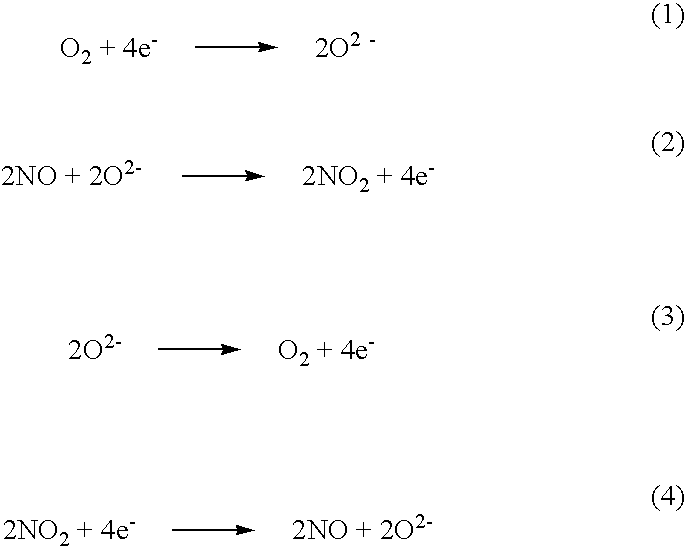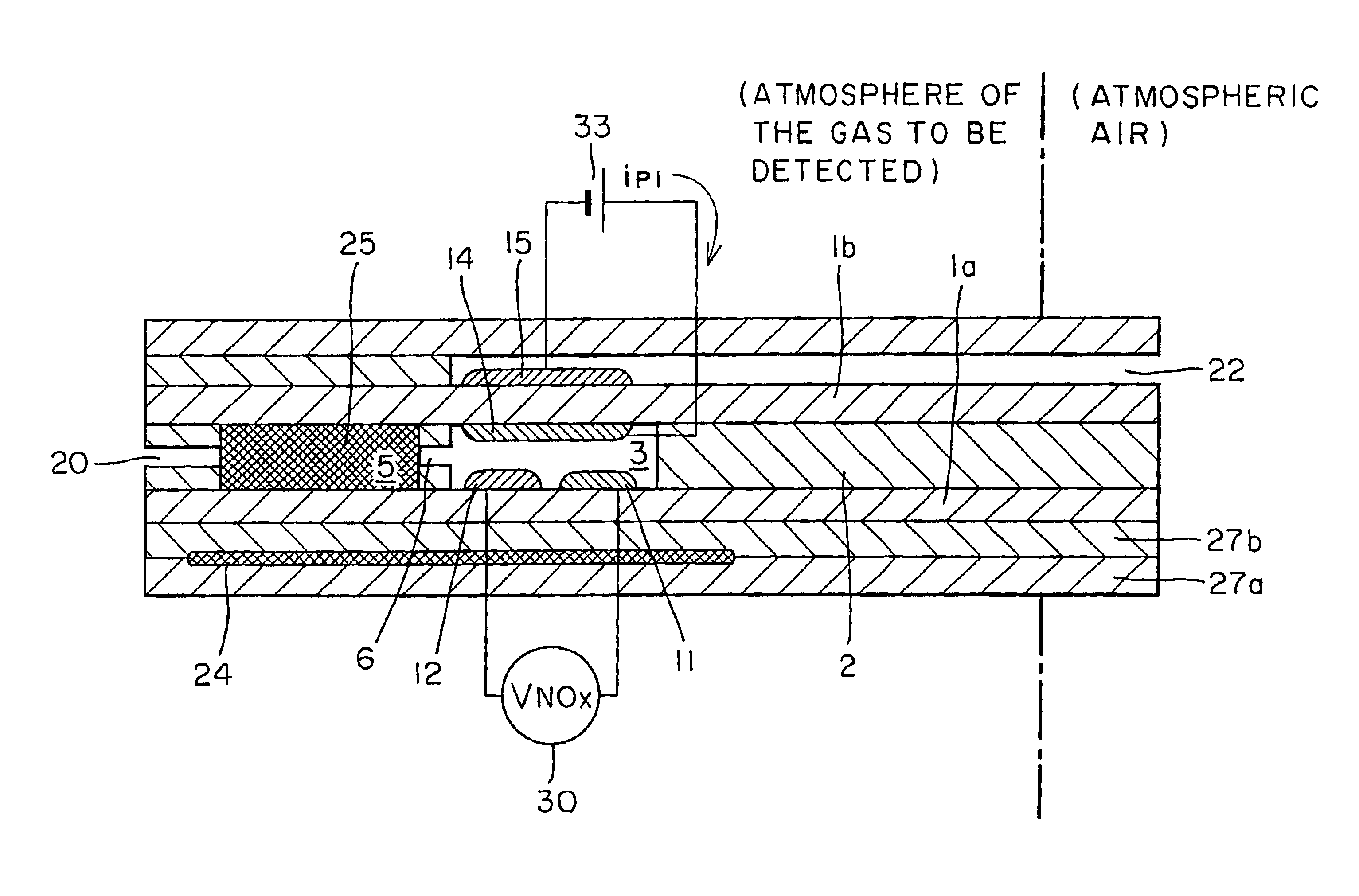NOx sensor
a technology of nox sensor and nox concentration, which is applied in the direction of liquid/fluent solid measurement, instruments, electrochemical variables of materials, etc., can solve the problems of affecting the detection accuracy of the nox concentration to be measured, the detection accuracy of the total nox concentration might become inaccurate, and the catalysis-based oxidation and removal described above becomes more difficult, etc., to achieve the effect of easy increase of the thickness of the layered substrate and higher temperatur
- Summary
- Abstract
- Description
- Claims
- Application Information
AI Technical Summary
Benefits of technology
Problems solved by technology
Method used
Image
Examples
example 2
As in the example 1, a NOx sensor having the oxidation catalyst pumping cell shown in FIG. 2 was fabricated. The cathode electrodes 17 and 15 of the oxidation catalyst pumping cell and the NOx conversion pumping cell, the reference electrode 12, and the heater 24 were printed using a Pt paste. The oxidation catalyst electrode 25 was formed of a Pt--Pd (5 wt %) alloy paste. Here, for the purpose of adjusting the electrode porosity, powdered zirconia solid electrolyte was added to the Pt--Pd (5 wt %) alloy paste so as to occupy approximately 20% of the post-fired electrode by volume.
The sensor sample fabricated thus was set into a measurement holder, and connected to the measuring circuit and control circuit shown in FIG. 2 for sensor characteristic evaluations. More specifically, the D.C. voltage source 34 was connected between the oxidation catalyst electrode 25 and its counter electrode 17. A constant voltage of 0.4 V was applied with the counter electrode 17 as the negative electr...
example 3
The same sample sensor device used in the example 2 was fabricated, and evaluated while changing the driving voltage to the oxidation catalyst pumping cell in the range of 0-0.9 V. That is, the oxidation catalyst electrode was checked for the voltage dependency of the electrochemical effect, which had been found in the example 2. Here, the oxygen concentration in the measured gas was set to 0% and 5%. In the meantime, for the purpose of evaluating the HC oxidation performance of the oxidation catalyst electrode, the oxidation catalyst pumping cell was also evaluated for the dependency of a HC oxidation current on the cell voltage. Here, the HC oxidation current was a difference between the base currents in the presence and absence of HC. That is, the greater the oxidation current, the higher the capability for oxidizing and removing reducing gases. FIGS. 18 and 19 show the measurements. In FIGS. 18 and 19, the data marked with .circle-solid. was at an oxygen concentration of 0%, and...
example 4
The same sample sensor device used in the example 2 was used to check for the relation between the oxidation current of the oxidation catalyst pumping cell and the oxygen concentration in the measured gas. Here, the concentration of C.sub.3 H.sub.6 was set at 1000 ppm (marked with .circle-solid. in the chart), 2000 ppm (marked with .largecircle. in the chart), and 5000 ppm (marked with .box-solid. in the chart). The driving voltage of the catalyst electrode pumping cell was 0.5 V. The other measured conditions were the same as those of the example 2. FIG. 20 shows the measurements. It is found that the oxidation current increases with an increasing concentration of C.sub.3 H.sub.6. The oxidation current also increases with a decreasing oxygen concentration of the measured gas. In particular it can be seen that the oxidation current increases abruptly at oxygen concentrations lower than or equal to 1%. This confirms that the oxidation catalyst electrode ensures the oxidation removal ...
PUM
| Property | Measurement | Unit |
|---|---|---|
| temperature | aaaaa | aaaaa |
| thickness | aaaaa | aaaaa |
| temperature | aaaaa | aaaaa |
Abstract
Description
Claims
Application Information
 Login to View More
Login to View More - R&D
- Intellectual Property
- Life Sciences
- Materials
- Tech Scout
- Unparalleled Data Quality
- Higher Quality Content
- 60% Fewer Hallucinations
Browse by: Latest US Patents, China's latest patents, Technical Efficacy Thesaurus, Application Domain, Technology Topic, Popular Technical Reports.
© 2025 PatSnap. All rights reserved.Legal|Privacy policy|Modern Slavery Act Transparency Statement|Sitemap|About US| Contact US: help@patsnap.com



